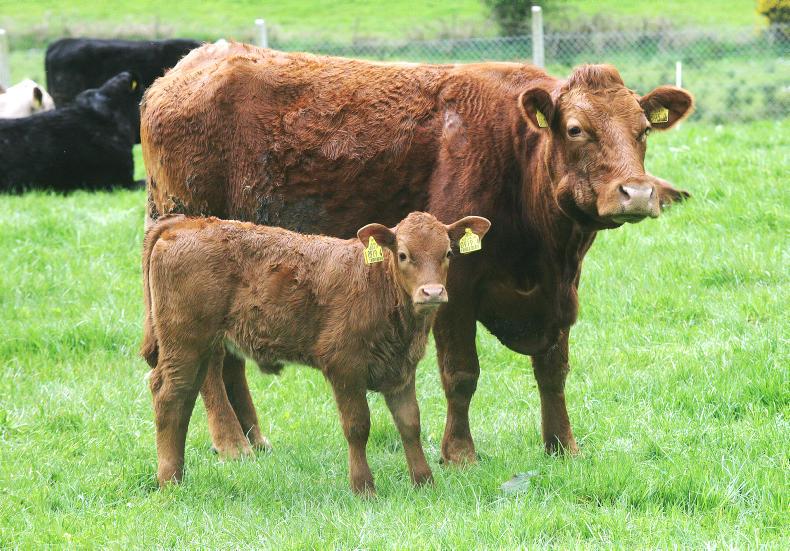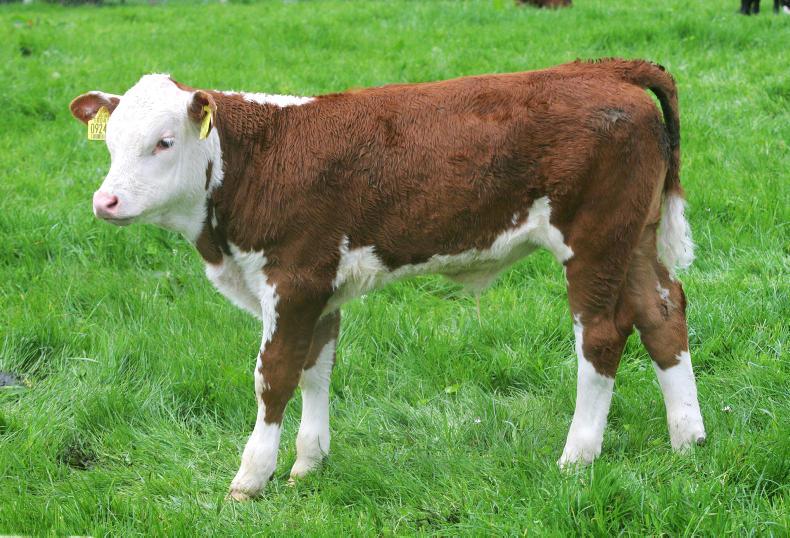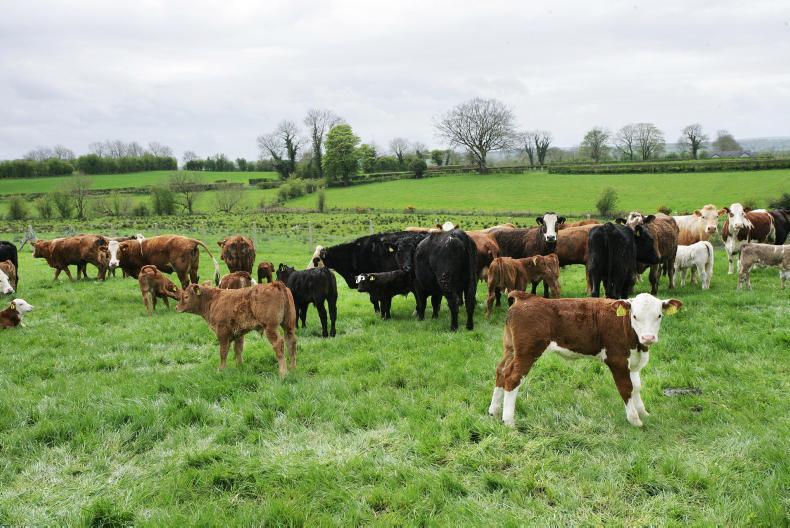Autumn calving started on 19 July, with a cow calving down nine days ahead of her scanning date. Thankfully, the calf was OK and is thriving well.
As of Saturday 22 August, 21 cows have calved from a total of 30 animals in the autumn herd. Overall, things have gone reasonably well, with the majority of cows and replacements calving on their own or with minimal assistance.

Autumn calving is well under way, with 21 out of 30 cows calved inside one month. Just one loss has been recorded, giving 20 cows with live calves on the ground.
From the 21 cows that have calved so far, there are 20 animals with a live calf at foot. The calf that died was born alive, but passed shortly afterwards.
The only other issue I had was with one cow that needed a caesarean section as the result of a twisted calf bed.
The animal was sectioned and the calf was born live and is suckling its mother. The cow is still in the shed and in the recovery period after the section.
Calving management
Cows were housed just prior to calving, as they were easier to manage and it freed up ground for animals after calving. The final nine cows left to calve are still indoors.
The cows that have calved are outside, grazing the paddocks surrounding the yard for close observation.

Calves are all sired by AI bulls, with Oliver using a combination of Simmental and Stabiliser on cows and Angus and Salers on heifers.
Cows are on a grass-only diet, along with mineral supplementation to cover them for tetany. Meal is only introduced to autumn cows once they are housed for breeding.
Grazing plans
The weather has really turned wet and paddocks are under pressure to carry stock. Cows are being moved regularly to fresh grass to keep them settled and limit sward damage.
Ideally, I would like to keep cows at grass for another month and house them around 1 October. This means cows are coming inside around two weeks before the breeding season.
I usually house the autumn cows by 1 October every year, as this gives them time to settle in the shed, as well as settling on to a silage diet before breeding starts.

Autumn cows and calves are grazing paddocks near to the main yard for close observation.
However, with ground getting wet and weather so unsettled, cows may have to be housed earlier than I would like.
Spring-calving cows
My spring-calving cows and calves have done well this year. The breeding season finished up around the end of July. My plans are to scan the cows in another two weeks time, which would be six weeks after the last animal was served.
I scanned the replacement heifers for the spring herd on Saturday 22 August and, from 10 animals served, there are nine settled in-calf. They were bred to AI using Angus and Salers bulls.
Planning for weaning
Spring-born calves will be vaccinated for pneumonia in the coming days and wormed at the same time. This should help prepare them for weaning and housing later on this autumn.
I don’t normally creep-feed calves at grass, but may consider introducing a feeder to the bull calves if it stays wet.
Having calves vaccinated, wormed and eating meal will be a big help in reducing stress
If the weather does not improve for September, then these animals may be weaned and housed earlier than normal.
So, having calves vaccinated, wormed and eating meal will be a big help in reducing stress from the change in environment. If calves are housed early, I will look at weaning early also.
Intensive feeding of autumn bulls
All male calves are finished as young bulls and there are 15 such animals due to be finished this winter. These animals have remained housed all summer, as grazing ground is limited and cows get priority.
The bulls were weighed last week and averaged 520kg at 11.3 months of age. The heaviest in the group is 676kg and was bred from the Stabiliser bull Stan the Man.
Bulls have now been built up on to 8kg/day of concentrate, along with good-quality silage bales. The ration being fed is still a growing ration, but it will be time to switch over to a finishing blend soon to get fat cover on bulls.

A group of 15 bulls born during autumn 2019 are being intensively fed for slaughter this winter.
If possible, I would like to hold bulls at 8kg/day for a while yet, then possibly step them up to 10kg/day for the last few weeks before they are slaughtered.
Silage will continue to be fed rather than straw, as I have found this to work well in the past. The bulls will be drafted for slaughter around 680kg to 700kg liveweight and before they hit 16 months of age.
Silage reserves
under pressure
Second-cut silage was finished up during the dry weather in mid-August, with 17ac lifted for the pit and 6ac baled up.
The pits would be less full than previous years, so I will be tight for silage and I am currently making enquiries to purchase additional fodder.
Surplus stock
I am also carrying surplus stock at present, so there will be some cattle that will have to be offloaded before the winter feeding period starts. This will ease some of the pressure on silage demand.
First-cut silage was analysed last week and the results were 28% dry matter, 11.75 ME, 13.36% protein, 73% D-Value.
This silage will be targeted to autumn-calving cows, to maintain milk production over winter, and growing cattle.
Feeding 2kg/day of concentrate during the breeding season will help to stretch reserves of first-cut silage and avoid big changes in diet that could impact conception rates.
Read more
Time to mind first-calved heifers
Beef management: five tips to prepare calves for weaning
Autumn calving started on 19 July, with a cow calving down nine days ahead of her scanning date. Thankfully, the calf was OK and is thriving well.
As of Saturday 22 August, 21 cows have calved from a total of 30 animals in the autumn herd. Overall, things have gone reasonably well, with the majority of cows and replacements calving on their own or with minimal assistance.

Autumn calving is well under way, with 21 out of 30 cows calved inside one month. Just one loss has been recorded, giving 20 cows with live calves on the ground.
From the 21 cows that have calved so far, there are 20 animals with a live calf at foot. The calf that died was born alive, but passed shortly afterwards.
The only other issue I had was with one cow that needed a caesarean section as the result of a twisted calf bed.
The animal was sectioned and the calf was born live and is suckling its mother. The cow is still in the shed and in the recovery period after the section.
Calving management
Cows were housed just prior to calving, as they were easier to manage and it freed up ground for animals after calving. The final nine cows left to calve are still indoors.
The cows that have calved are outside, grazing the paddocks surrounding the yard for close observation.

Calves are all sired by AI bulls, with Oliver using a combination of Simmental and Stabiliser on cows and Angus and Salers on heifers.
Cows are on a grass-only diet, along with mineral supplementation to cover them for tetany. Meal is only introduced to autumn cows once they are housed for breeding.
Grazing plans
The weather has really turned wet and paddocks are under pressure to carry stock. Cows are being moved regularly to fresh grass to keep them settled and limit sward damage.
Ideally, I would like to keep cows at grass for another month and house them around 1 October. This means cows are coming inside around two weeks before the breeding season.
I usually house the autumn cows by 1 October every year, as this gives them time to settle in the shed, as well as settling on to a silage diet before breeding starts.

Autumn cows and calves are grazing paddocks near to the main yard for close observation.
However, with ground getting wet and weather so unsettled, cows may have to be housed earlier than I would like.
Spring-calving cows
My spring-calving cows and calves have done well this year. The breeding season finished up around the end of July. My plans are to scan the cows in another two weeks time, which would be six weeks after the last animal was served.
I scanned the replacement heifers for the spring herd on Saturday 22 August and, from 10 animals served, there are nine settled in-calf. They were bred to AI using Angus and Salers bulls.
Planning for weaning
Spring-born calves will be vaccinated for pneumonia in the coming days and wormed at the same time. This should help prepare them for weaning and housing later on this autumn.
I don’t normally creep-feed calves at grass, but may consider introducing a feeder to the bull calves if it stays wet.
Having calves vaccinated, wormed and eating meal will be a big help in reducing stress
If the weather does not improve for September, then these animals may be weaned and housed earlier than normal.
So, having calves vaccinated, wormed and eating meal will be a big help in reducing stress from the change in environment. If calves are housed early, I will look at weaning early also.
Intensive feeding of autumn bulls
All male calves are finished as young bulls and there are 15 such animals due to be finished this winter. These animals have remained housed all summer, as grazing ground is limited and cows get priority.
The bulls were weighed last week and averaged 520kg at 11.3 months of age. The heaviest in the group is 676kg and was bred from the Stabiliser bull Stan the Man.
Bulls have now been built up on to 8kg/day of concentrate, along with good-quality silage bales. The ration being fed is still a growing ration, but it will be time to switch over to a finishing blend soon to get fat cover on bulls.

A group of 15 bulls born during autumn 2019 are being intensively fed for slaughter this winter.
If possible, I would like to hold bulls at 8kg/day for a while yet, then possibly step them up to 10kg/day for the last few weeks before they are slaughtered.
Silage will continue to be fed rather than straw, as I have found this to work well in the past. The bulls will be drafted for slaughter around 680kg to 700kg liveweight and before they hit 16 months of age.
Silage reserves
under pressure
Second-cut silage was finished up during the dry weather in mid-August, with 17ac lifted for the pit and 6ac baled up.
The pits would be less full than previous years, so I will be tight for silage and I am currently making enquiries to purchase additional fodder.
Surplus stock
I am also carrying surplus stock at present, so there will be some cattle that will have to be offloaded before the winter feeding period starts. This will ease some of the pressure on silage demand.
First-cut silage was analysed last week and the results were 28% dry matter, 11.75 ME, 13.36% protein, 73% D-Value.
This silage will be targeted to autumn-calving cows, to maintain milk production over winter, and growing cattle.
Feeding 2kg/day of concentrate during the breeding season will help to stretch reserves of first-cut silage and avoid big changes in diet that could impact conception rates.
Read more
Time to mind first-calved heifers
Beef management: five tips to prepare calves for weaning










 This is a subscriber-only article
This is a subscriber-only article









SHARING OPTIONS: